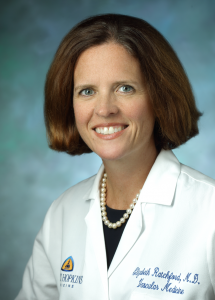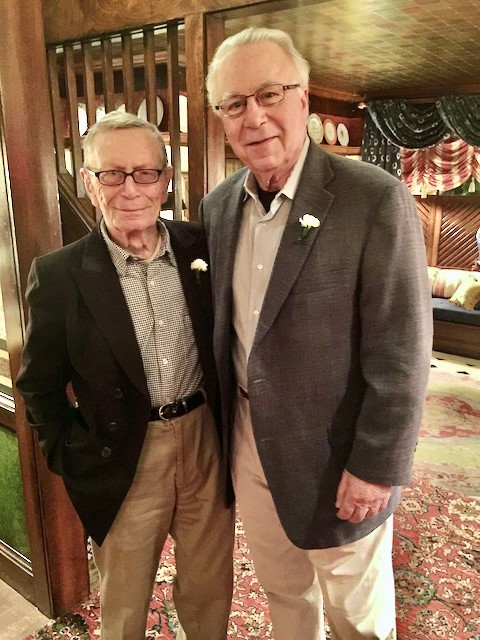To David Kotick, lovingly known to his family as Uncle Bernie, there were no strangers — only friends he had not met yet — and he counted Elizabeth Ratchford, MD, among them.
Ratchford, director of the Johns Hopkins Center for Vascular Medicine, met Uncle Bernie five years ago over lunch with his nephew Stanley Goldstein, a patient of Ratchford’s. Uncle Bernie was grateful for the care she provided to Goldstein, whom she treats for peripheral artery disease (PAD), and wanted to learn more about her work. They connected instantly, which came as no surprise to Goldstein.
“Uncle Bernie was able to bond with everyone. I always liked to describe him as everyone’s uncle. He just managed to find common ground with anybody,” says Goldstein, recalling that one of his uncle’s close friends was someone he met on a subway platform 45 years ago.

The luncheon was the only time Ratchford and Uncle Bernie met in person, but they remained in touch, thanks in part to Uncle Bernie’s expert editing skills. Ratchford is co-editor for the Patient Page section of the journal Vascular Medicine. When she learned of Uncle Bernie’s long career in the publishing industry, she invited him to serve on the journal’s patient panel, volunteers who review articles to ensure they make sense to a lay audience.
“I adored him from him the moment that I met him. He was just a larger than life kind of a guy,” Ratchford says. “He was one of the best members of our patient panel because he would always write me and give me helpful feedback. He would joke that he deserved an honorary medical degree because he had read so many of them. It was really fun to share that.”
Uncle Bernie passed away on March 8, 2021, at the age of 94, yet his connection to Ratchford endures through a generous gift in his will to support her research in the non-invasive diagnosis and treatment of vascular diseases.
Giving back was second nature for Uncle Bernie, Goldstein says. His uncle, a lifelong theater and opera lover, grew up in a tenement house in Brooklyn; worked in Manhattan, though his publishing career would take him around the globe; and retired in New York’s Catskill Mountains with his husband Donald. Until Goldstein was 5 years old, he lived next door to his uncle and grandparents. He remembers a pushka — Yiddish for “little box,” or in this case a tin can with a slot in the top — where spare change was collected and later donated to charities, including those dedicated to Holocaust survivors.
“They were helping people who couldn’t help themselves. I think Uncle Bernie and I, we just learned the importance of that. It carried through for the rest of his life, and it’s carried through to me as well,” says Goldstein, who also supports Ratchford’s work through annual gifts.

Ratchford has treated Goldstein, a real estate attorney in Potomac, Maryland, for PAD for more than a decade, and now sees him only for annual check-ups. The vascular disease is caused by atherosclerosis, or the buildup of plaque in the arteries, which blocks or reduces blood flow to the legs, making it painful to walk. PAD symptoms affect more than 20% of people over the age of 70 and left untreated can lead to a heart attack or stroke.
Quitting smoking and controlling blood pressure, cholesterol, and diabetes can reduce the risk of PAD. And exercise, a focus of Ratchford’s research, has been highly effective in improving symptoms. When Hopkins was one of the sites for the CLEVER (Claudication: Exercise Vs. Endoluminal Revascularization Trial), she looked at stents (small metal-mesh struts that can prop open an artery) versus exercise versus medical therapy alone for the treatment of PAD. Exercise therapy was so successful, it led to Medicare changing its guidelines to cover such therapy and to Hopkins building its PAD supervised exercise therapy program.
“Exercise is an extremely effective treatment; ideally, it should be supervised which has been harder due to the pandemic,” Ratchford notes. “At Hopkins, patients come to a center three times a week and are monitored on a treadmill. Usually, people can double the distance they can walk by the end of 12 weeks.”
Ratchford says that gifts like those from Uncle Bernie and Goldstein not only help her work; they can further her goal to support other researchers through a permanent vascular medicine fellowship program at Hopkins.
“Dr. Ratchford took the patient client relationship to a totally different level. I felt that she genuinely cared about me and wanted to provide the best possible medical advice and treatment that she could,” Goldstein says. “That feeling has continued to this day. I’m so happy that my uncle recognized her work in his estate plan.”
Interested in supporting research in the non-invasive diagnosis and treatment of vascular diseases?
Would you like to learn more about making a gift to support the future of the Heart and Vascular Institute?
Topics: Friends of Johns Hopkins Medicine, Heart and Vascular Institute, Fuel Discovery